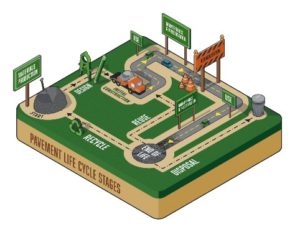
Sustainability is at the forefront of current events as we maintain our current standard of living for our current and future generations. Asphalt is the most sustainable material when it comes to constructing pavements. Even with asphalt pavement being a highly sustainable material there are further techniques you can utilize to create a more sustainable environment. Together with our help, your business can reduce its carbon footprint, reduce energy and reduce greenhouse gas emissions (GHG).
Our Recommended Sustainable asphalt preservation Techniques
Asphalt preservation treatment reduces the damaging effects of aging and deterioration of a pavement surface layer. Treatment also protects the underlying pavement structure and extends the remaining service life of your asphalt.
- Spray-applied surface seals. These are typically fog and rejuvenator seals that are diluted water-based emulsions that are sprayed onto asphalt surfaces by a distributor. These seals contribute to sustainability by sealing the pavement, enriching oxidized, and improved waterproofing.
- Thin overlays. Thin asphalt overlays are dense-graded small nominal asphalt mixture placed directly on existing pavement. It ranges in size of thickness from half an inch to one and a half inches.
- Crack treatment. When you have a crack in your asphalt paving it should be repaired immediately. By repairing cracks, you help preserve your asphalt surface which saves costs and cuts down on GHG emissions. Crack sealing prevents water from entering and destroying pavement and reduces energy, waste, and pollution over remove and replace repair methods.
- Chip seals. Chip seals are the application of asphalt emulsion and another layer of crushed rock to an existing asphalt surface.
- Slurry seal/micro surfacing. This technique is similar to spray seals such as fog except that slurry seals have aggregates mixed into the emulsion through a pugmill at the time of application.
- Surface recycling. Degraded pavement is modified and transformed into usable pavement. The benefits of this include: cost savings and conserving natural resources.
Takeaways
With proactive preservation, your asphalt pavement will decline less quickly. Crack sealing and asphalt sealcoating use the least amount of energy per year and are much for efficient than replacement. If you utilize preservation techniques you and avoid major rehabilitation of structural overlays and reconstruction which are quite costly. We can do our part to help the environment while also helping your business’s bottom line.
Contact Aegis
Our professionals utilize sustainable practices throughout our asphalt services in Eugene, Roseburg and Coos Bay. Contact Aegis to learn more.

